Public Health Essay: Vaccination Hesitancy and Its Global Implications
VerifiedAdded on 2023/04/22
|6
|1512
|241
Essay
AI Summary
This essay delves into the critical issue of vaccination hesitancy, particularly in the context of Australia, where declining child vaccination rates pose a significant public health challenge. The essay explores the various factors contributing to this hesitancy, including parental concerns about vaccine safety, misinformation, lack of awareness, and practical barriers to accessing vaccination services. It highlights the impact of hesitancy on national vaccination coverage, the increased risk of outbreaks of vaccine-preventable diseases, and the importance of addressing misconceptions through education and communication strategies. The essay emphasizes the need for healthcare providers and government agencies to develop effective strategies to build trust, provide accurate information, and encourage vaccination to protect public health and prevent the spread of diseases. It also underscores the long-term consequences of unvaccinated children and the importance of consistent follow-up advice for parents hesitant about vaccination.
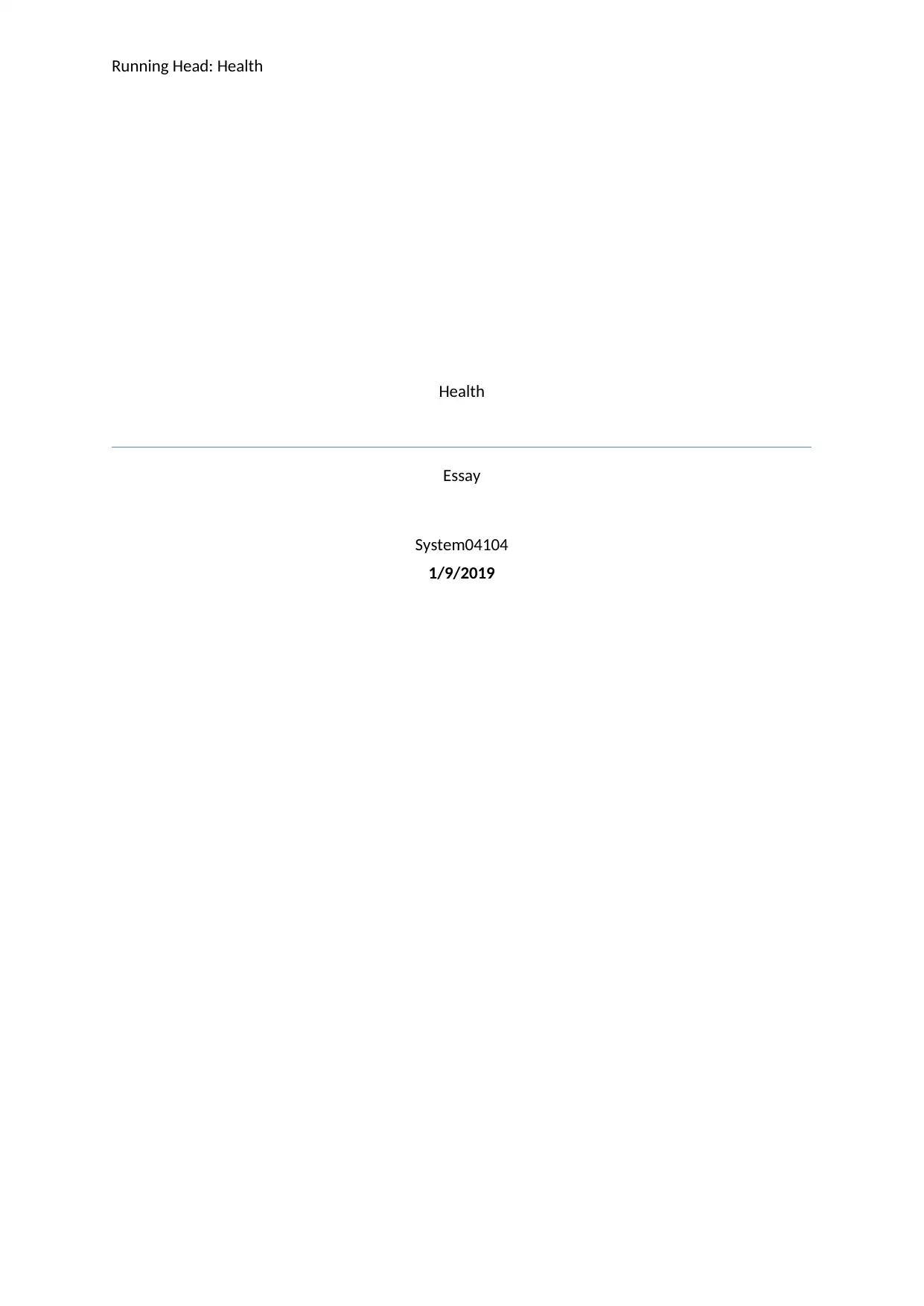
Running Head: Health
Health
Essay
System04104
1/9/2019
Health
Essay
System04104
1/9/2019
Paraphrase This Document
Need a fresh take? Get an instant paraphrase of this document with our AI Paraphraser
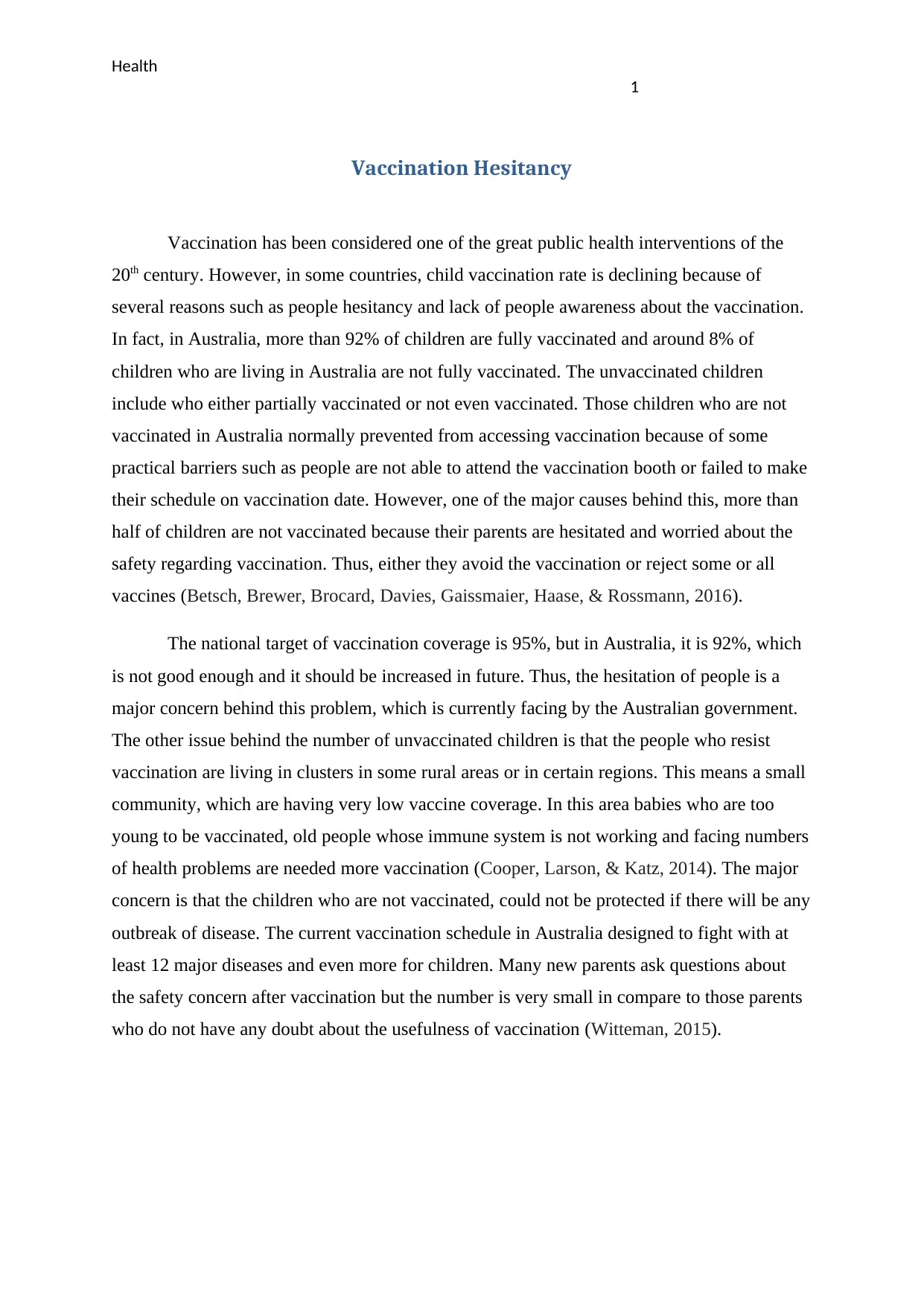
Health
1
Vaccination Hesitancy
Vaccination has been considered one of the great public health interventions of the
20th century. However, in some countries, child vaccination rate is declining because of
several reasons such as people hesitancy and lack of people awareness about the vaccination.
In fact, in Australia, more than 92% of children are fully vaccinated and around 8% of
children who are living in Australia are not fully vaccinated. The unvaccinated children
include who either partially vaccinated or not even vaccinated. Those children who are not
vaccinated in Australia normally prevented from accessing vaccination because of some
practical barriers such as people are not able to attend the vaccination booth or failed to make
their schedule on vaccination date. However, one of the major causes behind this, more than
half of children are not vaccinated because their parents are hesitated and worried about the
safety regarding vaccination. Thus, either they avoid the vaccination or reject some or all
vaccines (Betsch, Brewer, Brocard, Davies, Gaissmaier, Haase, & Rossmann, 2016).
The national target of vaccination coverage is 95%, but in Australia, it is 92%, which
is not good enough and it should be increased in future. Thus, the hesitation of people is a
major concern behind this problem, which is currently facing by the Australian government.
The other issue behind the number of unvaccinated children is that the people who resist
vaccination are living in clusters in some rural areas or in certain regions. This means a small
community, which are having very low vaccine coverage. In this area babies who are too
young to be vaccinated, old people whose immune system is not working and facing numbers
of health problems are needed more vaccination (Cooper, Larson, & Katz, 2014). The major
concern is that the children who are not vaccinated, could not be protected if there will be any
outbreak of disease. The current vaccination schedule in Australia designed to fight with at
least 12 major diseases and even more for children. Many new parents ask questions about
the safety concern after vaccination but the number is very small in compare to those parents
who do not have any doubt about the usefulness of vaccination (Witteman, 2015).
1
Vaccination Hesitancy
Vaccination has been considered one of the great public health interventions of the
20th century. However, in some countries, child vaccination rate is declining because of
several reasons such as people hesitancy and lack of people awareness about the vaccination.
In fact, in Australia, more than 92% of children are fully vaccinated and around 8% of
children who are living in Australia are not fully vaccinated. The unvaccinated children
include who either partially vaccinated or not even vaccinated. Those children who are not
vaccinated in Australia normally prevented from accessing vaccination because of some
practical barriers such as people are not able to attend the vaccination booth or failed to make
their schedule on vaccination date. However, one of the major causes behind this, more than
half of children are not vaccinated because their parents are hesitated and worried about the
safety regarding vaccination. Thus, either they avoid the vaccination or reject some or all
vaccines (Betsch, Brewer, Brocard, Davies, Gaissmaier, Haase, & Rossmann, 2016).
The national target of vaccination coverage is 95%, but in Australia, it is 92%, which
is not good enough and it should be increased in future. Thus, the hesitation of people is a
major concern behind this problem, which is currently facing by the Australian government.
The other issue behind the number of unvaccinated children is that the people who resist
vaccination are living in clusters in some rural areas or in certain regions. This means a small
community, which are having very low vaccine coverage. In this area babies who are too
young to be vaccinated, old people whose immune system is not working and facing numbers
of health problems are needed more vaccination (Cooper, Larson, & Katz, 2014). The major
concern is that the children who are not vaccinated, could not be protected if there will be any
outbreak of disease. The current vaccination schedule in Australia designed to fight with at
least 12 major diseases and even more for children. Many new parents ask questions about
the safety concern after vaccination but the number is very small in compare to those parents
who do not have any doubt about the usefulness of vaccination (Witteman, 2015).
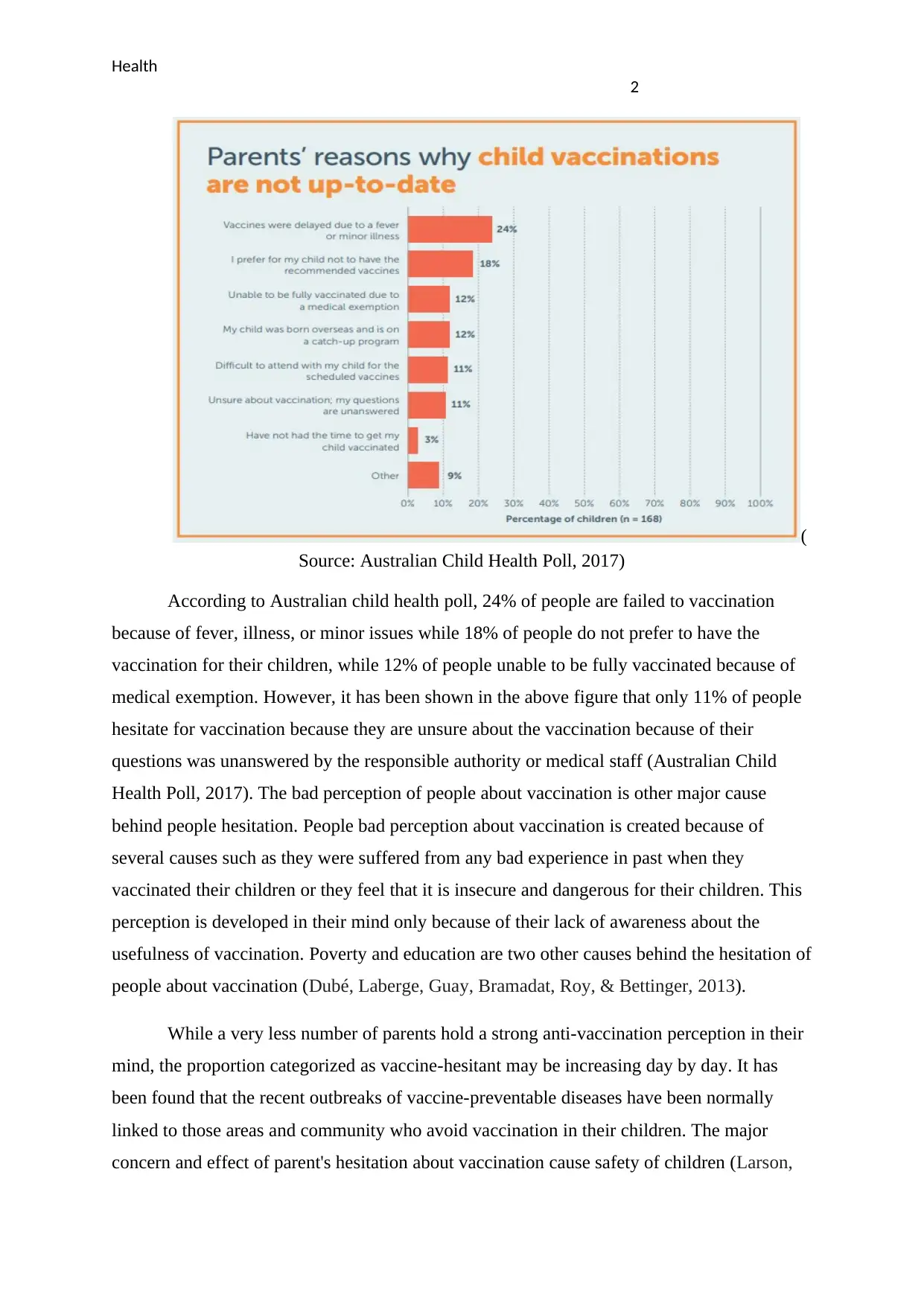
Health
2
(
Source: Australian Child Health Poll, 2017)
According to Australian child health poll, 24% of people are failed to vaccination
because of fever, illness, or minor issues while 18% of people do not prefer to have the
vaccination for their children, while 12% of people unable to be fully vaccinated because of
medical exemption. However, it has been shown in the above figure that only 11% of people
hesitate for vaccination because they are unsure about the vaccination because of their
questions was unanswered by the responsible authority or medical staff (Australian Child
Health Poll, 2017). The bad perception of people about vaccination is other major cause
behind people hesitation. People bad perception about vaccination is created because of
several causes such as they were suffered from any bad experience in past when they
vaccinated their children or they feel that it is insecure and dangerous for their children. This
perception is developed in their mind only because of their lack of awareness about the
usefulness of vaccination. Poverty and education are two other causes behind the hesitation of
people about vaccination (Dubé, Laberge, Guay, Bramadat, Roy, & Bettinger, 2013).
While a very less number of parents hold a strong anti-vaccination perception in their
mind, the proportion categorized as vaccine-hesitant may be increasing day by day. It has
been found that the recent outbreaks of vaccine-preventable diseases have been normally
linked to those areas and community who avoid vaccination in their children. The major
concern and effect of parent's hesitation about vaccination cause safety of children (Larson,
2
(
Source: Australian Child Health Poll, 2017)
According to Australian child health poll, 24% of people are failed to vaccination
because of fever, illness, or minor issues while 18% of people do not prefer to have the
vaccination for their children, while 12% of people unable to be fully vaccinated because of
medical exemption. However, it has been shown in the above figure that only 11% of people
hesitate for vaccination because they are unsure about the vaccination because of their
questions was unanswered by the responsible authority or medical staff (Australian Child
Health Poll, 2017). The bad perception of people about vaccination is other major cause
behind people hesitation. People bad perception about vaccination is created because of
several causes such as they were suffered from any bad experience in past when they
vaccinated their children or they feel that it is insecure and dangerous for their children. This
perception is developed in their mind only because of their lack of awareness about the
usefulness of vaccination. Poverty and education are two other causes behind the hesitation of
people about vaccination (Dubé, Laberge, Guay, Bramadat, Roy, & Bettinger, 2013).
While a very less number of parents hold a strong anti-vaccination perception in their
mind, the proportion categorized as vaccine-hesitant may be increasing day by day. It has
been found that the recent outbreaks of vaccine-preventable diseases have been normally
linked to those areas and community who avoid vaccination in their children. The major
concern and effect of parent's hesitation about vaccination cause safety of children (Larson,
⊘ This is a preview!⊘
Do you want full access?
Subscribe today to unlock all pages.

Trusted by 1+ million students worldwide
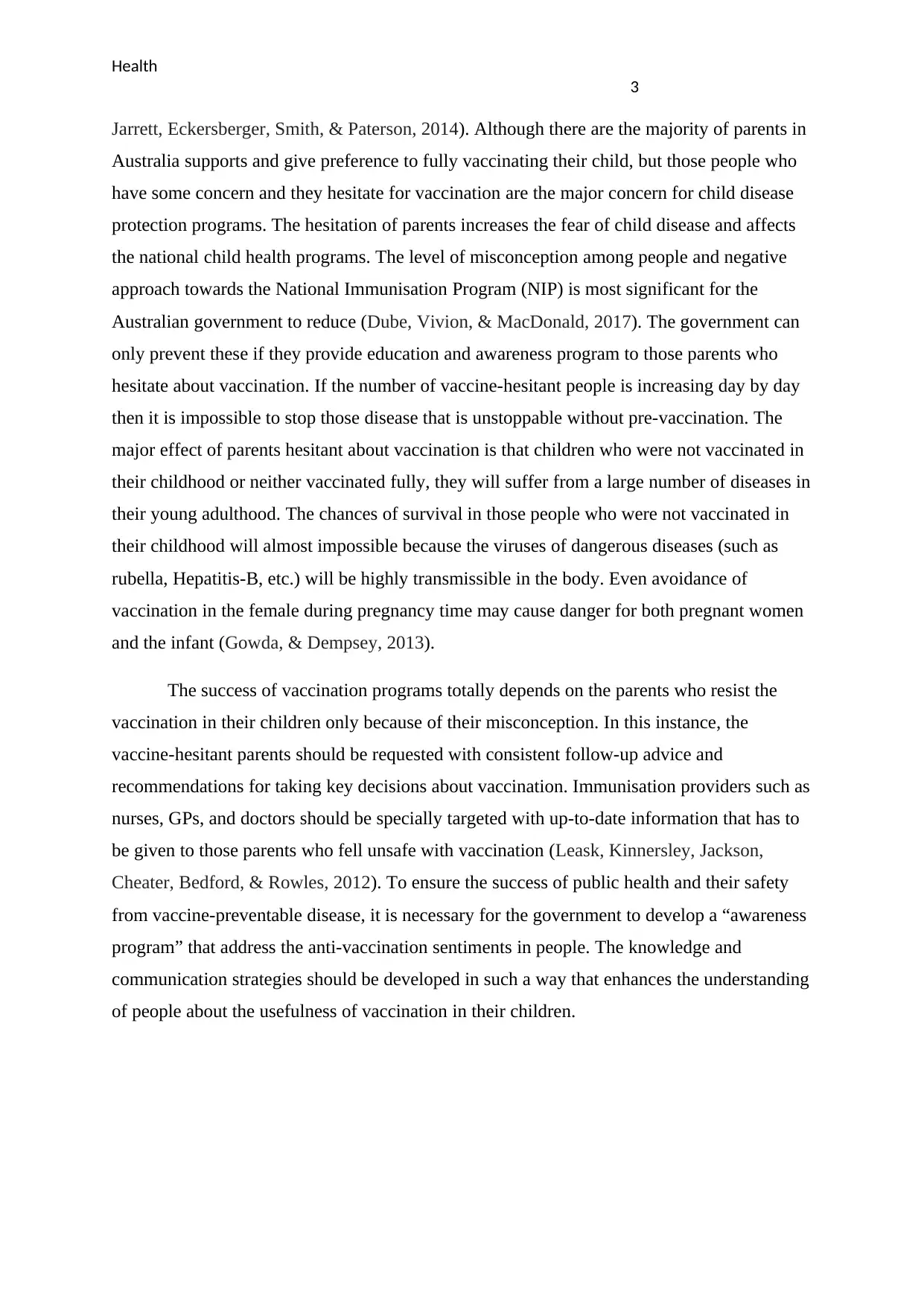
Health
3
Jarrett, Eckersberger, Smith, & Paterson, 2014). Although there are the majority of parents in
Australia supports and give preference to fully vaccinating their child, but those people who
have some concern and they hesitate for vaccination are the major concern for child disease
protection programs. The hesitation of parents increases the fear of child disease and affects
the national child health programs. The level of misconception among people and negative
approach towards the National Immunisation Program (NIP) is most significant for the
Australian government to reduce (Dube, Vivion, & MacDonald, 2017). The government can
only prevent these if they provide education and awareness program to those parents who
hesitate about vaccination. If the number of vaccine-hesitant people is increasing day by day
then it is impossible to stop those disease that is unstoppable without pre-vaccination. The
major effect of parents hesitant about vaccination is that children who were not vaccinated in
their childhood or neither vaccinated fully, they will suffer from a large number of diseases in
their young adulthood. The chances of survival in those people who were not vaccinated in
their childhood will almost impossible because the viruses of dangerous diseases (such as
rubella, Hepatitis-B, etc.) will be highly transmissible in the body. Even avoidance of
vaccination in the female during pregnancy time may cause danger for both pregnant women
and the infant (Gowda, & Dempsey, 2013).
The success of vaccination programs totally depends on the parents who resist the
vaccination in their children only because of their misconception. In this instance, the
vaccine-hesitant parents should be requested with consistent follow-up advice and
recommendations for taking key decisions about vaccination. Immunisation providers such as
nurses, GPs, and doctors should be specially targeted with up-to-date information that has to
be given to those parents who fell unsafe with vaccination (Leask, Kinnersley, Jackson,
Cheater, Bedford, & Rowles, 2012). To ensure the success of public health and their safety
from vaccine-preventable disease, it is necessary for the government to develop a “awareness
program” that address the anti-vaccination sentiments in people. The knowledge and
communication strategies should be developed in such a way that enhances the understanding
of people about the usefulness of vaccination in their children.
3
Jarrett, Eckersberger, Smith, & Paterson, 2014). Although there are the majority of parents in
Australia supports and give preference to fully vaccinating their child, but those people who
have some concern and they hesitate for vaccination are the major concern for child disease
protection programs. The hesitation of parents increases the fear of child disease and affects
the national child health programs. The level of misconception among people and negative
approach towards the National Immunisation Program (NIP) is most significant for the
Australian government to reduce (Dube, Vivion, & MacDonald, 2017). The government can
only prevent these if they provide education and awareness program to those parents who
hesitate about vaccination. If the number of vaccine-hesitant people is increasing day by day
then it is impossible to stop those disease that is unstoppable without pre-vaccination. The
major effect of parents hesitant about vaccination is that children who were not vaccinated in
their childhood or neither vaccinated fully, they will suffer from a large number of diseases in
their young adulthood. The chances of survival in those people who were not vaccinated in
their childhood will almost impossible because the viruses of dangerous diseases (such as
rubella, Hepatitis-B, etc.) will be highly transmissible in the body. Even avoidance of
vaccination in the female during pregnancy time may cause danger for both pregnant women
and the infant (Gowda, & Dempsey, 2013).
The success of vaccination programs totally depends on the parents who resist the
vaccination in their children only because of their misconception. In this instance, the
vaccine-hesitant parents should be requested with consistent follow-up advice and
recommendations for taking key decisions about vaccination. Immunisation providers such as
nurses, GPs, and doctors should be specially targeted with up-to-date information that has to
be given to those parents who fell unsafe with vaccination (Leask, Kinnersley, Jackson,
Cheater, Bedford, & Rowles, 2012). To ensure the success of public health and their safety
from vaccine-preventable disease, it is necessary for the government to develop a “awareness
program” that address the anti-vaccination sentiments in people. The knowledge and
communication strategies should be developed in such a way that enhances the understanding
of people about the usefulness of vaccination in their children.
Paraphrase This Document
Need a fresh take? Get an instant paraphrase of this document with our AI Paraphraser
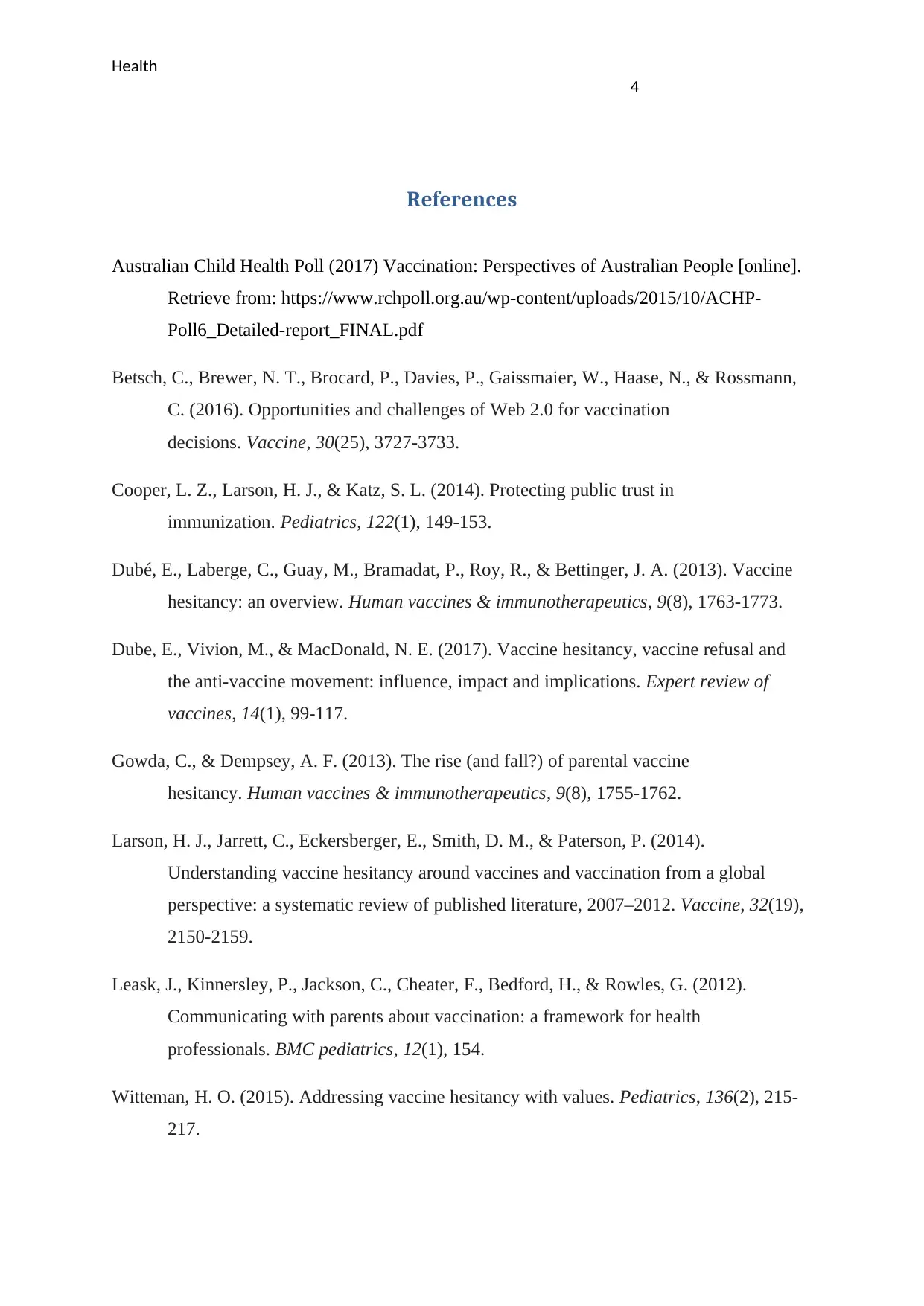
Health
4
References
Australian Child Health Poll (2017) Vaccination: Perspectives of Australian People [online].
Retrieve from: https://www.rchpoll.org.au/wp-content/uploads/2015/10/ACHP-
Poll6_Detailed-report_FINAL.pdf
Betsch, C., Brewer, N. T., Brocard, P., Davies, P., Gaissmaier, W., Haase, N., & Rossmann,
C. (2016). Opportunities and challenges of Web 2.0 for vaccination
decisions. Vaccine, 30(25), 3727-3733.
Cooper, L. Z., Larson, H. J., & Katz, S. L. (2014). Protecting public trust in
immunization. Pediatrics, 122(1), 149-153.
Dubé, E., Laberge, C., Guay, M., Bramadat, P., Roy, R., & Bettinger, J. A. (2013). Vaccine
hesitancy: an overview. Human vaccines & immunotherapeutics, 9(8), 1763-1773.
Dube, E., Vivion, M., & MacDonald, N. E. (2017). Vaccine hesitancy, vaccine refusal and
the anti-vaccine movement: influence, impact and implications. Expert review of
vaccines, 14(1), 99-117.
Gowda, C., & Dempsey, A. F. (2013). The rise (and fall?) of parental vaccine
hesitancy. Human vaccines & immunotherapeutics, 9(8), 1755-1762.
Larson, H. J., Jarrett, C., Eckersberger, E., Smith, D. M., & Paterson, P. (2014).
Understanding vaccine hesitancy around vaccines and vaccination from a global
perspective: a systematic review of published literature, 2007–2012. Vaccine, 32(19),
2150-2159.
Leask, J., Kinnersley, P., Jackson, C., Cheater, F., Bedford, H., & Rowles, G. (2012).
Communicating with parents about vaccination: a framework for health
professionals. BMC pediatrics, 12(1), 154.
Witteman, H. O. (2015). Addressing vaccine hesitancy with values. Pediatrics, 136(2), 215-
217.
4
References
Australian Child Health Poll (2017) Vaccination: Perspectives of Australian People [online].
Retrieve from: https://www.rchpoll.org.au/wp-content/uploads/2015/10/ACHP-
Poll6_Detailed-report_FINAL.pdf
Betsch, C., Brewer, N. T., Brocard, P., Davies, P., Gaissmaier, W., Haase, N., & Rossmann,
C. (2016). Opportunities and challenges of Web 2.0 for vaccination
decisions. Vaccine, 30(25), 3727-3733.
Cooper, L. Z., Larson, H. J., & Katz, S. L. (2014). Protecting public trust in
immunization. Pediatrics, 122(1), 149-153.
Dubé, E., Laberge, C., Guay, M., Bramadat, P., Roy, R., & Bettinger, J. A. (2013). Vaccine
hesitancy: an overview. Human vaccines & immunotherapeutics, 9(8), 1763-1773.
Dube, E., Vivion, M., & MacDonald, N. E. (2017). Vaccine hesitancy, vaccine refusal and
the anti-vaccine movement: influence, impact and implications. Expert review of
vaccines, 14(1), 99-117.
Gowda, C., & Dempsey, A. F. (2013). The rise (and fall?) of parental vaccine
hesitancy. Human vaccines & immunotherapeutics, 9(8), 1755-1762.
Larson, H. J., Jarrett, C., Eckersberger, E., Smith, D. M., & Paterson, P. (2014).
Understanding vaccine hesitancy around vaccines and vaccination from a global
perspective: a systematic review of published literature, 2007–2012. Vaccine, 32(19),
2150-2159.
Leask, J., Kinnersley, P., Jackson, C., Cheater, F., Bedford, H., & Rowles, G. (2012).
Communicating with parents about vaccination: a framework for health
professionals. BMC pediatrics, 12(1), 154.
Witteman, H. O. (2015). Addressing vaccine hesitancy with values. Pediatrics, 136(2), 215-
217.

Health
5
5
⊘ This is a preview!⊘
Do you want full access?
Subscribe today to unlock all pages.

Trusted by 1+ million students worldwide
1 out of 6
Related Documents
Your All-in-One AI-Powered Toolkit for Academic Success.
+13062052269
info@desklib.com
Available 24*7 on WhatsApp / Email
![[object Object]](/_next/static/media/star-bottom.7253800d.svg)
Unlock your academic potential
Copyright © 2020–2025 A2Z Services. All Rights Reserved. Developed and managed by ZUCOL.





